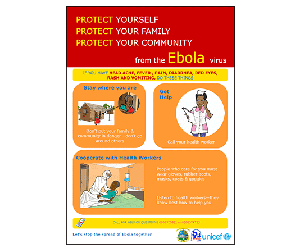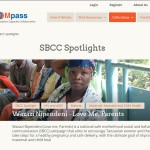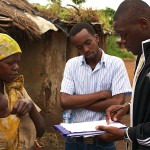The Art of Adaptation When Adapting Communication Materials in a Hurry
If you Google “brochure” and “family planning,” you get page after page of links to brochures, most of them to reputable materials you can use. But replace “family planning” with “Ebola,” and there aren’t so many options.
The outbreak, and our response, is simply too new. If you are in need of a brochure (or poster or radio spot or whole communication strategy) for Ebola – and you need it now, of course – you are going to have to build one. Luckily, you won’t have to do it from scratch.
There are communication materials for Ebola, and the Ebola Communication Network is making sure that they are being shared. But even if you find something that you think might meet your communication needs, you still are going to have to adapt it. Why? Because communication materials work best when they are specifically designed with an audience, topic and action in mind.
 For example, this nice poster was developed by the Ministry of Health and Social Welfare (MOHSW) and UNICEF in Liberia. Let’s say you want to use it somewhere else. Would it work? Could you just change the hotline number and the country logo and order a print run? Here are some things to consider before you do.
For example, this nice poster was developed by the Ministry of Health and Social Welfare (MOHSW) and UNICEF in Liberia. Let’s say you want to use it somewhere else. Would it work? Could you just change the hotline number and the country logo and order a print run? Here are some things to consider before you do.
1. What is my goal? What do I want people to know and do?
These are the first questions to ask. If the material doesn’t clearly and directly address the knowledge, behaviors or beliefs that you want to change, you are going to have to do an adaptation. This poster, for example, would be appropriate if your goal is for people to know the symptoms, call for help when they are sick and allow care by health care workers. This poster is appropriate in an active epidemic context where people have access to Ebola Treatment Units. But if you are working in a context where there are currently no Ebola cases but the community needs to prepare for a possible epidemic, the messaging will change to awareness of the signs and symptoms, rather than seeking care. In other words, your communication goal is going to be different in different places, and it will need to change over time as the situation changes, and your materials will need to change as well.
2. Is it right for my audience?
On a very basic level, you need to be sure that the people you are trying to reach can access and understand the information. If you are trying to reach poor women in an urban slum, because they are the family caregivers, you’ll need to be careful that the material is appropriate for a low literacy audience, and that the materials appeal to and catch the eye of the people who need to see it. So first define your audience, and then make sure the material is accessible and understandable to them. Two areas in particular are important when adapting for specific audiences:
Language: People are most likely to absorb the message of a material if the language is the language spoken in their home and community. Even if someone can speak English (or French, or what have you), the material might be more effective in a native tongue, especially if the material contains information that is influenced by culture. That creates a trade off: translating into multiple local languages and creating distribution plans for different sets of materials is more expensive and more time consuming than producing material in one language, and having one plan for its dissemination. But a material that isn’t understood or is ignored because it is perceived as coming from outside the community isn’t going to work, and that is an even bigger waste of time and money.
Images: Like language, pictures matter. If the material has graphics of people, houses, food, etc. they should look like the people, houses and food of the community for which the material is designed. Sometimes the graphics are simple enough that specific cultural or geographic cues aren’t noticeable, but often they are vitally important and getting it wrong can cause offense.
3. Is the information correct for my context?
Information that is correct in one context may be dead wrong in another. Carefully review the material to make sure that the information lines up with what local authorities are advising. Make sure hotline numbers, addresses and names of service providers are locally adapted.
4. Does the material have key messages?
Even if the information is generally what you want to communicate, materials are most effective when they have a few key messages. The Liberia poster is a good example of focus on a few key messages: the symptoms of Ebola and the steps to take if you have it. Sometimes communication materials can get too wordy or have too much information to absorb. Stick to a few key messages and if there is more information that is essential to communicate, put it on another material and distribute as companion pieces or try a different format.
There are many situations where a print material (or a radio PSA, or other short form mass communication) isn’t the appropriate way to communicate information. Complicated, in-depth information or information that contradicts cultural norms is best conveyed inter-personally or using video. This allows for back-and-forth communication with a trusted source (in the case of interpersonal communication) or at least modeling of behavior (in the case of a video). An example of complicated information would be how to care for sick family members at home while waiting for help. The instruction is best done by community health workers, while a print material or PSA could be used to encourage people to talk to those workers to get more information.
A sub-category of the key message is the “call to action,” which is the behavior you want people to take as a result of exposure to your material. This should never be ambiguous to you or your audience. Examples might be: “if someone in your family has a fever, call for care” or “protect yourself and your family, don’t touch dead bodies.” You should test the exact language of your call to action with the community to be sure you get it right.
So, say you have found a material that seems very close to what you need for your intervention. You have determined that it is appropriate for your audience, translated it into a few local languages and adjusted the language so it has a few key messages and a call to action that fits your context. Can you send it to the print house? Nope, not yet. One last important step.
5. Pre-test.
Before you invest time and money in producing materials, you need to be sure the audience understands them and reacts to them the way you intend. A pre-test doesn’t need to be formal or conducted by researchers. Here is a guide to conducting pretesting. When it comes to pretesting, do what you can do. Don’t decide to do none at all because you can’t do it the way the book tells you to. Any feedback is better than none.
Finally, a plea. If you are developing Ebola communication materials, or adapting existing materials,please share them with the Ebola Communication Network so others can adapt them all over again.








Leave a Reply
Want to join the discussion?Feel free to contribute!